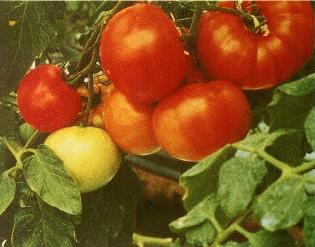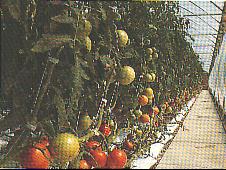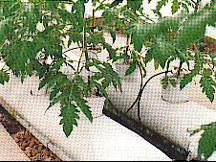David Hall
Pershore College of Horticulture
United Kingdom

| Research Report | PERLITE |
|
Perlite in Hydroponics |
PLANT GUIDE |
|
The Schundler Company 10 Central Street Nahant, MA 01908 732-287-2244 |
THE ROLE OF PERLITE IN HYDROPONIC CULTURE
and GROWING HYDROPONIC CROPS USING PERLITE
David Hall
Pershore College of Horticulture
United Kingdom

Watering
As a rooting medium, perlite is superiorto rockwool. The outstanding feature of perlite is the ease with whicha constant supply of water and nutrients can be maintained in the substratesimply by placing the plant container in a shallow reservoir of nutrientsolution. Perlite's strong capillary attraction for water automaticallydraws up solution from the reservoir at the same rate that water is removedby the plants. Nutrient enriched water is trapped in the tiny irregularities onthe surface pf perlite particles where it is available for use by plant roots.Excess solution remains in the reservoir. The ease with which an optimum moisturelevel can be maintained around roots is the key to perlite's success and it is asignificant advantage over rockwool which has less capillarity.
Rockwool is close to being waterloggedat its maximum water-holding capacity, when it can hold as much as 85%water by volume and, hence, too little air for optimum root developmentand growth. Perlite's free-draining nature means that it retains less thanhalf this amount of water. Roots in perlite are always well aerated andwell watered.
In contrast to perlite, the moisture content ofrockwool fluctuates from too wet (just after watering) to too dry (just beforewatering). To minimize such fluctuations, growers using rockwool must resort to a'little-and-often' watering routine. Nutrient solution may have to be added torockwool slabs as often as 24 times per day. Fertilizer and Water Costs
To avoid the possibility of waterloggingwhen rockwool is used, polyethylene sleeves of rockwool slabs should beslit to drain out excess nutrient solution. This continual waste of waterand fertilizers can increase the combined cost of these items to more thandouble that for perlite culture where a reservoir system can be easilyadapted. Re-Use Perlite is physically stable and, unlikerockwool, will retain its excellent air/water balance for many years ifhandled carefully. Some growers have used perlite for tomatoes more thanone growing season and it has subsequently been re-used for potting mixesand soil conditioning. If perlite is reused, sterilization may benecessary. Summary
Photos of Typical Perlite Hydroponic Operations
The Schundler Company
Back to Horticultural Main Page


For more information about these uses of perlite and vermiculite, please call or contact us at:
10 Central Street
Nahant, MA 01908
(ph)732-287-2244 (fax) 732-287-4185
www.schundler.com
email: info@schundler.com